I'm relatively new to breadmaking and I've been lurking here quite a bit. I think it's about time I made my first post, but since I want to show off my bread, why not make it a blog post?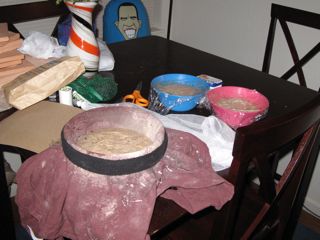

[i]^ Whole wheat sourdough ready for their overnight retard. Obama lurks in the background, waiting. Some 14 hours later, the boule pops out of the oven.[/i]
Lately I've been increasingly obsessed with baking (well, eating) the best damn whole wheat sourdough. WGB got me off to a good start, as did Laurel's but, ehh... something was missing. WGB was an amazing read, but its hearth bread made with sourdough... it was dense, chewy, and not at all what I wanted. The flavor was maybe not the right kind of nutty. So what it came down to was me searching this site inside out. There's [url=http://www.thefreshloaf.com/node/5898/stretch-and-fold-technique-clarification]quite[/url] [url=http://www.thefreshloaf.com/node/1040/lesson-squeeze-more-sour-your-sourdough]a bit[/url] of [url=http://www.thefreshloaf.com/node/5821/shaping-dough-video]valuable information[/url] [url=http://www.thefreshloaf.com/node/12940/100-sourdough-pain-de-tradition-85-hydration-miche-pointeacalliere-or-pain-poilane]around these parts[/url]! [url=http://www.thefreshloaf.com/node/13977/quotbacking-upquot-my-starter]This last link also saved my sanity once or twice.[/url] :p
There were plenty of flat loafs in between, but I think I've got it.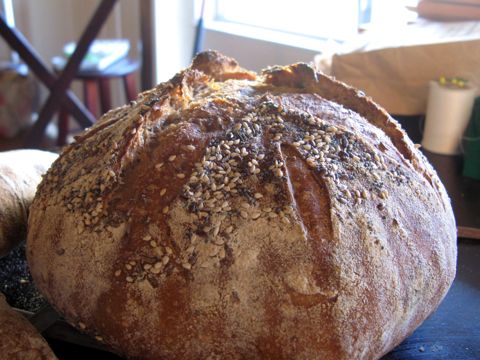
[i]^Bam.[/i]
I used 100% hydration sourdough starter that's ~3 months old. The final hydration was 82%.
I'm happy with how the loaf turned out. The oven spring was far better than I expected. I think the final tweak that made everything "click" was to not flip the dough onto a flat board for scoring, but into a shallow, parchment-lined bowl. The curvature of the bowl angled the dough in such a way that I got a flat surface to score. It made the dough look somewhat deflated and scoring actually harder without the surface tension, but somehow the "liveliness" of the dough was preserved better in the end. I scored the dough, then lifted it out by the parchment and dumped the whole affair into a covered 3.6 quart wide-lipped casserole. The casserole was also another great discovery. I dug it out of a thrift store intending to use the flat lid as a base, but found that using it right-side up gave the loaf juuust the right amount of structural support while still being largely free standing. I baked the loaf at 450 degrees for 30 minutes, and that was that.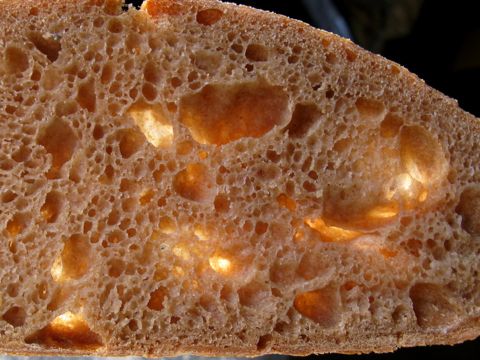
[i]^ The crumb.[/i]
I also whipped up some 115% hydration dough/batter for a shot at ciabatta.
[i]^ The ciabatta posing with the boule in the back.[/i]
Like the round, I made an overnight soaker containing half the final flour and all of the salt and water. The ciabatta soaker was so hydrated that the water and flour gave up and separated into their own sedimentary layers. Not pretty. The next day I added the starter and remaining flour and stretch-and-folded it in the container with one hour rests in between. After the 3rd set of folding, the batter started peel easily from the container and I decided to divide dough into two and placed 'em in the fridge.
I wasn't expecting much of the ciabatta. It was just a side experiment, and the open vent on my aging oven makes steaming futile. I've gotten around on the boule with the glass casserole, but for the ciabatta, I just cranked my oven up to as high as it'll go and chucked in the ciabatta on the tiles for 10-15 minutes. There still managed to be pretty good oven spring.
So, how'd it do?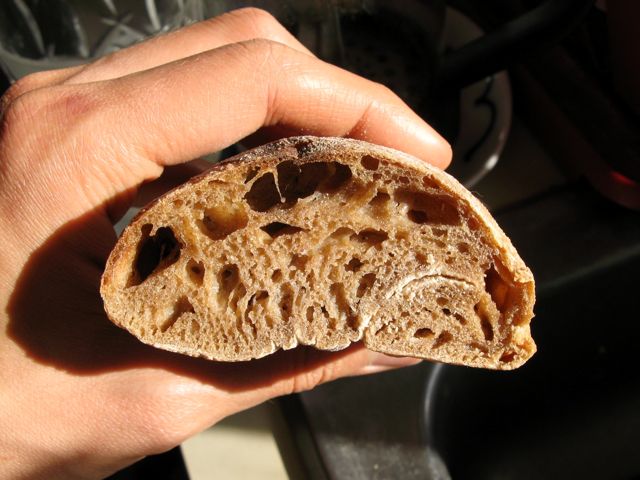
[i]^ Damn. Either it was under-kneaded or flour simply wasn't meant to be this hydrated.[/i]
I ended up getting a cavern, and over-floured it while trying to shape it. Oh well; that didn't stop the bread from being some of the most deliciously airy and fluffy bread I've tasted with just the right tang. Once the excess flour was vigorously patted off, anyways.
So, there you go. If anyone would like the full recipe for the ciabatta, I'd be happy to post it. I'm still tweaking the hydration and so forth.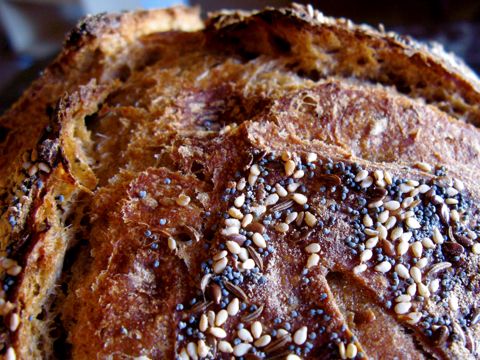
[i]^ One last shot of the crust. Btw, apologies if the pictures seem washed out, poorly composed, or whatever. I'm not a photographer by any means.[/i]
Whole Wheat Sourdough
| Soaker | grams |
| whole wheat flour | 230 g |
| salt | 4 g |
| water | 340 g |
| Final | grams |
| soaker | 574 g |
| starter (100% hydration) |
140 g |
| salt | 3-5 g |
| whole wheat flour | 200 g |
| total | 917 g |
- On the day before:
- Refresh the starter and thoroughly mix the soaker ingredients.
- Cover the soaker and let it sit for 12 to 24 hours at room temperature for an overnight autolyse.
- Mixing and first rise:
- Mix all final ingredients. Let the dough rest for 15 minutes, then [url=http://thebackhomebakery.com/Tutorials/NoKnead.html]stretch-and-fold in the bowl[/url] to ensure hydration is even. Cover the bowl, and let it sit at room temperature for 45 minutes.
- I pre-heated an insulated proofing box (a cooler) with a heat pad set to "low". The ambient temperature should be around 90 degrees.
- [url=http://www.thefreshloaf.com/node/5898/stretch-and-fold-technique-clarification]Stretch-and-fold the dough 3 times[/url], with one hour rests following each iteration in the proofing box.
- Shaping and final proof:
- [url=http://www.thefreshloaf.com/node/5821/shaping-dough-video]Pre-shape, rest 15 minutes, then shape.[/url] Place the dough in cloth-lined proofing basket and cover snuggly with plastic wrap. Let the dough rest for 15 minutes.
- Place the basket immediately in the refrigerator for a 12-24 hour overnight rise.
- [url=http://www.thefreshloaf.com/node/5821/shaping-dough-video]Pre-shape, rest 15 minutes, then shape.[/url] Place the dough in cloth-lined proofing basket and cover snuggly with plastic wrap. Let the dough rest for 15 minutes.
- Baking:
- Remove the dough from the refrigerator and let it rest for 90 minutes.
- Meanwhile, preheat oven to 475 F with a baking stone and a covered 3.6 qt glass casserole.
- Flip the dough into a shallow, parchment-lined bowl. Score the dough.
- Place the dough in the casserole, cover it, and bake for 30-35 minutes at 450 F degrees.
- Caltrain's Blog
- Log in or register to post comments
Hi Caltrain,
We apparently have the same taste. Nice bread! I might try it myself, if I manage to fit it into my schedule. Thank you for reporting in such great detail!
Salome
You achieved an amazing crumb for 100% whole wheat! Your research and patience have paid off! Are you using a modified version of the whole wheat hearth bread from WGB?
Thanks for the comments!
But yes, the recipe is a bastardized version of Reinhart's recipe. I've tried many loafs with all but 30 grams of flour added to the soaker as written in the book. His other recipes work great, but the basic nothing-extra sourdough loaf never got me anything much more than a frisbee. I think chiefly the problem is that there's no dedicated sourdough hearth bread recipe in the book, per se. Reinhart just instructs you to substitute starter for the biga, which contributes to something like 45%-ish percent of the final dough's weight. That's quite a bit of starter!
I've also noticed that, oddly enough, using reinhart's epoxy approach gives me a much wetter dough to work with. Maybe it's not a bad thing, but it seems that the flour, for whatever reason, isn't quite asorbing all the water.
could you explain the glass casserole, you said it held the shape very well. how tall was your casserole? should there be any space left when putting the dough in it? i am going to start learning how to make sourdough breads next year so am collecting as many tips as I can!
Sure, it's a little under 5 inchs tall, with maybe... 4 3/4" clearance? The sloped sides supports the base of the loaf which lifts the loaf into a rounder shape. It's uhh... sort of like a pushup bra for bread.
Going in, there's plenty of vertical room between the dough and the loaf. Coming out of the oven, there is barely any clearance left. Here's a picture of the thing:
Just to go a bit more into the casserole, I foolishly tossed away the packaging before noting who made it in case I ever needed a replacement. Google turned up [url=http://web.kavalier.cz/en/site/katalog/SimaxCollection/01_pekace_misy/01_pekace_misy.html?productid=3595]a result[/url] which seems pretty similar to what I have. I'm sure any casserole with sloped sides and enough clearance should do as well of a job.
appreciate it. i think i might have one sitting in my cupboard...
Thanks so much for your post, very helpful & I used it to bake my first successful boule. I have some questions for you. :) May I ask why it is necessary to do the soaker overnight vs. an hour or so? Does it make much of a difference? Also, why add the salt in the soaker rather than add it all at once with the final mix? Thanks so much!
The purpose of the soaker is to give the amylase enzymes time to convert damaged starch to sugar. It takes more than a few hours at room temperature. The salt keeps the protease enzymes in check.
A classic autolyse, which has no salt, only takes 30--90 minutes. Its purpose is to hydrate the flour and start gluten formation.
Thanks for your reply. I did more research & understand the process much better.
I just searched around TFL & found all the answers I could ever want about my questions. THanks for posting your bread & the steps you took to make it, it was very helpful for me.
Beautiful bread!